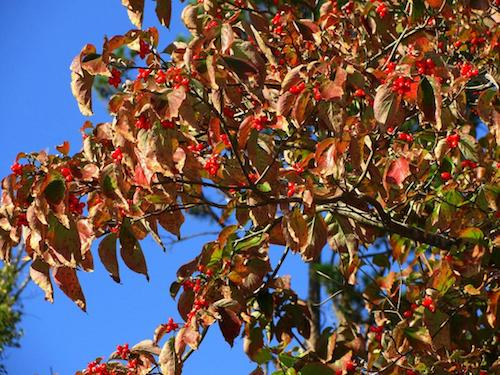
Flowering dogwoods are beautiful in the fall as well as the spring.
December 26, 2023 - Now is a good time to both care for and plant one of our most beloved native trees. Flowering dogwood is one of the most popular and showy small flowering trees in Eastern North America. It however reaches its western limits in East Texas.
Cornus florida is happiest in acidic, sandy loam soils with good drainage and regular moisture. It prefers high shade or basically the same areas in a landscape that grow azaleas, camellias, gardenias, and hydrangeas well.
Too much water and dogwoods die. Too little water and dogwoods die. Too much clay and dogwoods die. Plant them too deep and dogwoods die. Direct western sun or reflected heat and dogwoods suffer from sun scorch. Too little sun and dogwoods don’t bloom. Nick them with a lawn mower or string trimmer and dogwoods get life-threatening borers. Plant a grafted red or a pink one and it’s more likely to die than a native white one. They also get anthracnose and powdery mildew.
So, why on earth do we attempt to grow the spoiled brats? Because they are beautiful, graceful, and spectacular, that’s why. Plus, the birds love them too. I can’t imagine though how many dogwoods have been sacrificed for every nice one we see though. Part of the problem is geography. Because we are on the southwestern edge of their natural distribution, our weather is too hot, too sunny, and too dry during the summertime and too erratic and mild during the wintertime. We also tend to cut down the trees around them exposing them to blistering hot sun that they aren’t used to.
Genetics are also a huge problem for us. Unfortunately, the provenance (ancestral genetics) of almost all the dogwoods we purchase at the nursery are from seed collected in the Eastern United States where the plants evolved with milder summers, colder winters, and more regular rainfall. That means the genetics of the plants we are growing don’t know anything about Texas and most likely aren’t fond of it. Our best choices in order of ease of growing would be volunteer native seedlings, seedlings from a local source, white seedlings from any source, grafted white cultivars, grafted pink cultivars, grafted red cultivars, and lastly grafted variegated cultivars. Certainly, containerized trees are preferred with fall planting best, winter planting second best, spring planting third, and summer planting worst.
Dogwoods must absolutely be planted in well drained sandy loam soils (not clays) and generally need one inch of irrigation about every two weeks during June, July, and August, minus rainfall. They should always be mulched with a thick layer of organic matter (pine straw or coarse organic material), should never be exposed to hot direct sun on their trunks (wrap them like maples when they are young), should never be planted too deep, and should never have their trunks bumped, scraped, or damaged.
If you want to grow your own dogwoods from locally collected seed (from nice native specimens or well-established garden selections) the red-ripe berries need to be macerated (red pulp removed) and cleaned, seed stratified (stored in the refrigerator in moist sand, vermiculite, or perlite) for 3-4 months before planting. Otherwise, plant a nice healthy containerized plant, do not disturb the root ball, and pamper it like a prized princess.
Greg Grant is the Smith County horticulturist for the Texas A&M AgriLife Extension Service. He is the author of Texas Fruit and Vegetable Gardening, Texas Home Landscaping, Heirloom Gardening in the South, and The Rose Rustlers. You can read his “Greg’s Ramblings” blog at arborgate.com and read his “In Greg’s Garden” in each issue of Texas Gardener magazine (texasgardener.com). More science-based lawn and gardening information from the Texas A&M AgriLife Extension Service can be found at aggieturf.tamu.edu and aggie-horticulture.tamu.edu.








